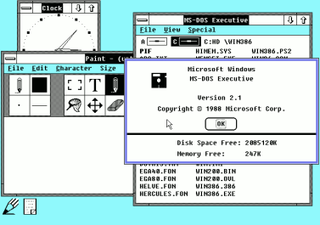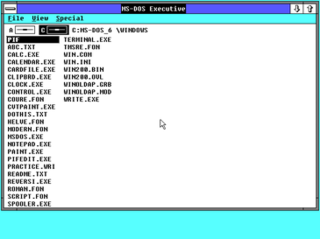Related Research Articles

Microsoft PowerPoint is a presentation program, created by Robert Gaskins and Dennis Austin at a software company named Forethought, Inc. It was released on April 20, 1987, initially for Macintosh computers only. Microsoft acquired PowerPoint for about $14 million three months after it appeared. This was Microsoft's first significant acquisition, and Microsoft set up a new business unit for PowerPoint in Silicon Valley where Forethought had been located.

The Handheld Device Markup Language (HDML) is a markup language intended for display on handheld computers, information appliances, smartphones, etc.. It is similar to HTML, but for wireless and handheld devices with small displays, like PDA, mobile phones and so on.

Adobe PageMaker is a desktop publishing computer program introduced in 1985 by the Aldus Corporation on the Apple Macintosh. The combination of the Macintosh's graphical user interface, PageMaker publishing software, and the Apple LaserWriter laser printer marked the beginning of the desktop publishing revolution. Ported to PCs running Windows 1.0 in 1987, PageMaker helped to popularize both the Macintosh platform and the Windows environment.
DataFlex is an object-oriented high-level programming language and a fourth generation visual tool for developing Windows, web and mobile software applications on one framework-based platform. It was introduced and developed by Data Access Corporation beginning in 1982.

Imaging for Windows from Global 360 is document imaging software. Earlier versions of Imaging for Windows were available for Windows 95-98/Me/NT/2000. Global360 Imaging for Windows is the upgrade to this Imaging software, which was discontinued as of Windows XP. Its image viewing, editing and scanning functions are superseded by Windows Picture and Fax Viewer and Microsoft Paint, both of which are based on GDI+ in Windows XP. However, the multi-page picture editing functions are gone with the Imaging software.
CommSuite 95 is a communications software suite launched in 1995 by Canadian software company Delrina.

Irma board, originally spelled IRMA board, refers to a brand of coaxial interface cards for PCs and Macintosh computers used to enable 3270 emulator programs to connect to IBM mainframe computers. IRMA boards were used to connect PCs and Macs to IBM 3274 terminal controllers.
Red Ryder is a communications and terminal emulation software program released for the Apple Macintosh in 1984. Initially distributed as a shareware, the application offered rich features and configuration settings. Red Ryder was discontinued in 1989 and replaced by White Knight.
XDB Enterprise Server is a relational database management system (DBMS), which was available for DOS, Windows NT and OS/2, and was compatible with IBM's DB2 database. DOS version was released in 1988 as one of the earliest DOS-based SQL database servers. The system was developed by XDB Systems, Inc., which was acquired by Micro Focus International group in 1998. It is still shipped with Micro Focus' COBOL software.
Simeon was an IMAP4 email client by The Esys Corporation with support for IMSP and LDAP.
LiveWire Professional is a MS-DOS program made by CableSoft. It was first introduced in 1988 as software/expansion board combination, which allowed to convert Financial News Network ticker from television receivers into ASCII for further analysis. The software is designed for stock brokers and financial analysts, allowing them to record and analyse the stock market, through the use of live feeds. However, its user interface was criticized as cumbersome.
Aldus PhotoStyler was a graphics software program developed by the Taiwanese company Ulead. Released in June 1991 as the first 24 bit image editor for Windows, it was bought the same year by the Aldus Prepress group. Its main competition was Adobe Photoshop. Version 2.0 introduced a new user interface and improved color calibration. PhotoStyler SE - lacking some features of the version 2.0 - was bundled with scanners like HP ScanJet. The product disappeared from the Adobe product line after Adobe acquired Aldus in 1994.
Courier was an email client for Microsoft Windows. The software was originally released in 1996 as Calypso by Micro Computer Systems (MCS).

Windows 2.1 is a major release of Microsoft Windows. It was released to manufacturing on May 27, 1988, as a successor to Windows 2.0.

Windows 3.1 is a major release of Microsoft Windows. It was released to manufacturing on April 6, 1992, as a successor to Windows 3.0.

Windows 2.0 is a major release of Microsoft Windows, a family of graphical operating systems for personal computers developed by Microsoft. It was released to manufacturing on December 9, 1987, as a successor to Windows 1.0.
The Zinc Application Framework is an application framework, intended for the development of cross-platform software applications with graphical user interface (GUI), using a widget toolkit. Zinc targets both embedded and desktop platforms.
LINDO is a software package for linear programming, integer programming, nonlinear programming, stochastic programming and global optimization.
PerfectDisk is a defragmentation software product for Windows developed by Raxco.

The IBM ThinkPad 365 is a notebook computer series developed by IBM and manufactured by ASE Group. It was released in North America in November 1995, and was the successor of the ThinkPad 360 series. The series had 8 models that were released before being discontinued, and was succeeded in 1997 by the ThinkPad 380 series.
References
- ↑ "Macintosh News, Meeting Maker now available". InfoWorld. Vol. 13, no. 11. IDG. March 18, 1991. p. 38. ISSN 0199-6649.
- ↑ Kosiur, Dave (November 1991). "Meeting Maker, Microsoft Schedule+ 1.0". Macworld. Vol. 8, no. 11. Macworld Communications. pp. 239–240. ISSN 0741-8647.
- ↑ Pompili, Tony (November 9, 1993). "With Meeting Maker, PC and Mac Users Can Get Together". PC Magazine. Vol. 12, no. 19. Ziff Davis. p. 56. ISSN 0888-8507.
- ↑ Lipschutz, Robert P. (December 15, 1998). "First looks, Meet You on the Web". PC Magazine. Vol. 17, no. 22. Ziff Davis. p. 75. ISSN 0888-8507.
- ↑ Marshall, Patrick (August 25, 1995). "Meeting Maker XP beefs up back end". InfoWorld. Vol. 18, no. 35. IDG. pp. 95–96. ISSN 0199-6649.
- ↑ Schindler, Esther (March 12, 1996). "First looks, Meeting Maker XP for OS/2: The Cross-Platform Scheduler". PC Magazine. Vol. 15, no. 5. Ziff Davis. p. 51. ISSN 0888-8507.
- ↑ Cox, John (2010-12-16). "Notify unveils multi-platform management software for mobile devices". Network World. Retrieved 2023-04-17.